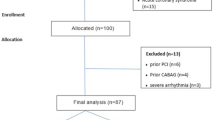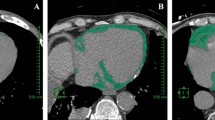Abstract
Background
Increased epicardial fat volume (EFV) has been shown to be associated with coronary atherosclerosis. While it is postulated to be an independent risk factor, a possible mechanism is local or systemic inflammation. We analyzed the relationship between coronary atherosclerosis, quantified by coronary calcium in CT, epicardial fat volume and systemic inflammation.
Methods
Using non-enhanced dual-source CT, we quantified epicardial fat volume (EFV) and coronary artery calcium (CAC) in 391 patients who underwent coronary computed tomography for suspected coronary artery disease. In addition to traditional risk factors, serum markers of systemic inflammation were measured (IL-1α, IL-2, IL-4, IL-6, IL-7, IL-8, IL-10,IL-12, IL-13, IL-15, IL-17, IFN-γ, TNF-α, hs-CRP, GM-CS, G-CSF, MCP-1, MIP-1, Eotaxin and IP-10). In 94 patients follow-up data were obtained after 1.9 ± 0.5 years.
Results
The 391 patients had a mean age of 60 ± 10 years, and 69 % were males. Mean EFV was 116 ± 50 mL. Median CAC was 12 (IQR 0; 152). CAC and EFV showed a significant correlation (ρ = 0.37; P < 0.001). EFV and CAC were significantly correlated with the traditional risk factors like age, male gender, diabetes, smoking and hypertension. With regard to biomarkers, CAC was significantly associated (negatively) to G-CSF and IL-13. EFV (median binned) was significantly associated (positively) with IP-10 (P = 0.002) and MCP-1 (ρ = 0.037). In follow-up, EFV showed a mean annualized progression of 6 mL (IQR 3; 9) (P < 0.001); CAC progressed by a mean of six Agatston Units (IQR 0; 30). The progression of CAC was significantly correlated with the extent of EFV (P < 0.001) while there was no significant correlation between progression of EFV or CAC with systemic inflammation markers.
Conclusion
Epicardial fat volume and the baseline extent as well as progression of coronary atherosclerosis—measured by the calcium score—are significantly correlated. While both baseline EFV and CAC displayed significant correlations with systemic inflammation markers, biomarkers were not predictive of the progression of CAC or EFV.



Similar content being viewed by others
Abbreviations
- 95 % CI:
-
95 % Confidence interval
- AU:
-
Agatston units
- BMI:
-
Body mass index
- CAC:
-
Coronary artery calcification
- CAD:
-
Coronary artery disease
- CT:
-
Computed tomography
- CVD:
-
Cardiovascular disease
- EFV:
-
Epicardial fat volume
- HU:
-
Hounsfield units
- IQR:
-
Interquartile range (lower; upper quartile)
- mSv:
-
Millisievert
- VOI:
-
Volume of interest
References
Ross R. Atherosclerosis—an inflammatory disease. N Engl J Med. 1999;340:115–26.
Burdon KP, Langefeld CD, Beck SR, Wagenknecht LE, Carr JJ, Rich SS, et al. Variants of the CD40 gene but not of the CD40L gene are associated with coronary artery calcification in the Diabetes Heart Study (DHS). Am Heart J. 2006;151:706–11.
Oei HH, Sayed-Tabatabaei FA, Hofmann A, Oudkerk M, van Duijn CM, Witteman JC. The association between angiotensin-converting enzyme gene polymorphism and coronary calcification: the Rotterdam Coronary Calcification Study. Atherosclerosis. 2005;182:169–73.
Reilly MP, Wolfe ML, Dykhouse J, Reddy K, Localio AR, Rader DJ. Intercellular adhesion molecule 1 (ICAM-1) gene variant is associated with coronary artery calcification independent of soluble ICAM-1 levels. J Investig Med. 2004;52:515–22.
Khera A, de Lemos JA, Peshock RM, Lo HS, Stanek HG, Murphy SA, et al. Relationship between C-reactive protein and subclinical atherosclerosis: the Dallas Heart Study. Circulation. 2006;113:38–43.
Wang TJ, Larson MG, Levy D, Benjamin EJ, Kupka MJ, Manning WJ, et al. C-reactive protein is associated with subclinical epicardial coronary calcification in men and women: the Framingham Heart Study. Circulation. 2002;106:1189–91.
Raaz-Schrauder D, Klinghammer L, Baum C, Frank T, Lewczuk P, Achenbach S, et al. Association of systemic inflammation markers with the presence and extent of coronary artery calcification. Cytokine. 2012;57:251–7.
Tadros TM, Massaro JM, Rosito GA, Hoffmann U, Vasan RS, Larson MG, et al. Pericardial fat volume correlates with inflammatory markers: the Framingham Heart Study. Obesity. 2010;18:1039–44.
Hirata Y, Kurobe H, Akaike M, Chikugo F, Hori T, Bando Y, et al. Enhanced inflammation in epicardial fat in patients with coronary artery disease. Int Heart J. 2011;52:139–42.
Baker AR, Silva NF, Quinn DW, Harte AL, Pagano D, Bonser RS, et al. Human epicardial adipose tissue expresses apathogenic profile of adipocytokines in patients with cardiovascular disease. Cardiovasc Diabetol. 2006;5:1.
Deo R, Khera A, McGuire DK, Murphy SA, Meo Neto Jde P, Morrow DA, et al. Association among plasma levels of monocyte chemoattractant protein 1, traditional cardiovascular risk factors and subclinical atherosclerosis. J Am Coll Cardiol. 2004;44:1812–8.
Konishi M, Sugiyama S, Sato Y, Oshima S, Sugamura K, Nozaki T, et al. Pericardial fat inflammation correlates with coronary artery disease. Atherosclerosis. 2010;213:649–55.
Iacobellis G, Barbaro G. The double role of epicardial adipose tissue as pro- and anti-inflammatory organ. Horm Metabo Res. 2008;40:442–5.
Iacobellis G, Pistilli D, Gucciardo M. Adiponectin expression in human epicardial adipose tissue in vivo is lower in patients with coronary artery disease. Cytokine. 2005;29:251–5.
Mazurek T, Zhang L, Zalewski A. Human epicardial adipose tissue is a source of inflammatory mediators. Circulation. 2003;108:2460–6.
Kremen J, Dolinkova M, Krajickova J. Increased subcutaneous and epicardial adipose tissue production of proinflammatory cytokines in cardiac surgery patients: possible role in postoperative insulin resistance. J Clin Endocrinol Metab. 2006;91:4620–7.
Iacobellis G, Corradi D, Sharma AM. Epicardial adipose tissue: anatomic, biomolecular and clinical relationships with the heart. Nat Clin Pract Cardiovasc Med. 2005;2:536–43.
Iacobellis G, Pond CM, Sharma AM. Different “weight” of cardiac and general adiposity in predicting left ventricle morphology. Obesity. 2006;14:1679–84.
Sacks HS, Fain JN. Human epicardial adipose tissue: a review. Am Heart J. 2007;153:907–17.
Gordon S. Do macrophage innate immune receptors enhance atherogenesis? Dev Cell. 2003;5:666–8.
Hofmann U, Knorr S, Vogel B, Weirather J, Frey A, Ertl G, et al. Interleukin-13 deficiency aggravates healing and remodeling in male mice after experimental myocardial infarction. Circ Heart Fail. 2014;7:822–30.
Moreno PR, Falk E, Palacios IF, Newell JB, Fuster V, Fallon JT. Macrophage infiltration in acute coronary syndromes Implications for plaque rupture. Circulation. 1994;90:775–8.
Libby P. Molecular bases of the acute coronary syndromes. Circulation. 1995;91:23844–50.
Krishnaswamy G, Kelley J, Yerra L, Smith JK, Chi DS. Human endothelium as a source of multifunctional cytokines: molecular regulation and possible role in human disease. J Interferon Cytokine Res. 1999;19:91–104.
Greif M, Becker A, von Ziegler F, Lebherz C, Lehrke M, Broedl UC, et al. Pericardial adipose tissue determined by dual source CT is a risk factor for coronary atherosclerosis. Arterioscler Thromb Vasc Biol. 2009;29:78–86.
Agatston AS, Janowitz WR, Hildner FJ, Zusmer NR, Viamonte M Jr, Detrano R. Quantification of coronary artery calcium using ultrafast computed tomography. J Am Coll Cardiol. 1990;15:827–32.
Budoff MJ, Achenbach S, Blumenthal RS, Carr JJ, Goldin JG, Greenland P, et al. Assessment of coronary artery disease by cardiac computed tomography: a scientific statement from the American Heart Association Committee on Cardiovascular Imaging and Intervention, Council on Cardiovascular Radiology and Intervention, and Committee on Cardiac Imaging Council on Clinical Cardiology. Circulation. 2006;114:1761–91.
Detrano R, Guerci AD, Carr JJ, Bild DE, Burke G, Folsom AR, et al. Coronary calcium as a predictor of coronary events in four racial or ethnic groups. N Engl J Med. 2008;358:1336–45.
Lakoski SG, Greenland P, Wong ND, Schreiner PJ, Herrington DM, Kronmal RA, et al. Coronary artery calcium scores and risk for cardiovascular events in women classified as ‘‘low risk’’ based on Framingham risk score: the multiethnic study of atherosclerosis (MESA). Arch Intern Med. 2007;167:2437–42.
Zheng Y, Higuera FV, Zhou SK Fast and automatic heart isolation in 3d ct volumes: optimal shape initialization. IMLMI 2010: 84–91.
Rosito GA, Massaro JM, Hoffmann U, Ruberg FL, Mahabadi AA, Vasan RS, et al. Pericardial fat, visceral abdominal fat, cardiovascular disease risk factors, and vascular calcification in a community-based sample: the Framingham Heart Study. Circulation. 2008;117:605–13.
Ding J, Hsu FC, Harris TB, Liu Y, Kritchevsky SB, Szklo M, et al. The association of pericardial fat with incident coronary heart disease: the Multi-Ethnic Study of Atherosclerosis (MESA). Am J Clin Nutr. 2009;90:499–504.
Krueger K, Klocke R, Kloster J, Nikol S, Waltenberger J, Mooren FC. Activity of dialy living is associated with circulating CD34 +/KDR + cells and granulocyte colony-stimulating factor levels in pateints after myocardial infarction. J Appl Physiol. 2014;116:532–7.
Ait-Oufella H, Taleb S, Mallat Z, Tedgui A. Recent advances on the role of cytokines in atherosclerosis. Arterioscler Thromb Vasc Biol. 2011;31:969–79.
Bruno S, Bussolati B, Scacciatella P, Marra S, Sanavio F, Tarella C, et al. Combined administration of G-CSF and GM-CSF stimulates monocyte-derived pro-angiogenic cells in patients with acute myocardial infarction. Cytokine. 2006;34:56–65.
Klinghammer L, Urschel K, Cicha I, Lewczuk P, Raaz-Schrauder D, Achenbach S, et al. Impact of telmisartan on the inflammatory state in patients with coronary atherosclerosis—influence on IP-10, TNF-α and MCP-1. Cytokine. 2013;62:290–6.
Author information
Authors and Affiliations
Corresponding author
Additional information
Responsible Editor: Artur Bauhofer.
Rights and permissions
About this article
Cite this article
Gauss, S., Klinghammer, L., Steinhoff, A. et al. Association of systemic inflammation with epicardial fat and coronary artery calcification. Inflamm. Res. 64, 313–319 (2015). https://doi.org/10.1007/s00011-015-0809-x
Received:
Revised:
Accepted:
Published:
Issue Date:
DOI: https://doi.org/10.1007/s00011-015-0809-x




